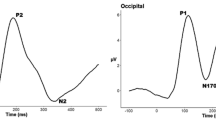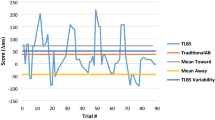Abstract
Background
Anxiety and posttraumatic stress symptoms have been associated with threat-related attention bias assessed in the widely-used dot-probe task. A novel method of scoring attention bias using response-based computation has shown improved reliability over standard computation approaches with adult samples.
Methods
The current study applies this approach using secondary analysis of dot probe data from a sample of preschool-aged children ages 3–7 (n = 280) with varying levels of violence exposure. Attention bias indices were then examined alongside mother-report and observational measures of child anxiety. The standard approach used average reaction times to create a single measure of vigilant or avoidant bias per participant, whereas the response-based computation approach used trial-level reaction times to dissociate separate measures of vigilant and avoidant bias per participant.
Results
The standard computation approach demonstrated unacceptable levels of internal consistency. In contrast, response-based computation of vigilant and avoidant bias demonstrated good and acceptable levels of internal consistency, respectively. Using the standard computation approach, no significant symptom associations were observed. Using the response-based computation approach greater ratio of vigilant bias relative to avoidant bias (i.e., vigilant bias > avoidant bias) was related to more observed anxious behaviors.
Conclusions
Similar to research in adults, response-based attention bias indices demonstrated superior psychometric properties and stronger symptom associations compared to the standard computation approach and may offer advantages over the standard computation approach to study attention bias in young children.

Figure used from Evans and Britton (2018) with permission from Elsevier

Similar content being viewed by others
Data Availability
Data for this study is not publicly available.
References
Aktar, E., Van Bockstaele, B., Pérez-Edgar, K., Wiers, R. W., & Bögels, S. M. (2019). Intergenerational transmission of attentional bias and anxiety. Developmental Science, 22(3), 1–19. https://doi.org/10.1111/desc.12772
American Psychiatric Association. (2000). Diagnostic and statistical manual of mental disorders (4th ed., Text Revision). Washington, DC.
Bar-Haim, Y. (2010). Research review: Attention bias modification (ABM): A novel treatment for anxiety disorders. Journal of Child Psychology and Psychiatry and Allied Disciplines, 51(8), 859–870. https://doi.org/10.1111/j.1469-7610.2010.02251.x
Bar-Haim, Y., Lamy, D., Pergamin, L., Bakermans-Kranenburg, M. J., & van IJzendoorn, M. H. (2007). Threat-related attentional bias in anxious and nonanxious individuals: A meta-analytic study. Psychological Bulletin, 133(1), 1–24. https://doi.org/10.1037/0033-2909.133.1.1
Briggs-Gowan, M. J., Pollak, S. D., Grasso, D., Voss, J., Mian, N. D., Zobel, E., McCarthy, K. J., Wakschlag, L. S., & Pine, D. S. (2015). Attention bias and anxiety in young children exposed to family violence. Journal of Child Psychology and Psychiatry, 56(11), 1194–1201. https://doi.org/10.1111/jcpp.12397
Briggs-Gowan, M. J., Grasso, D., Bar-Haim, Y., Voss, J., McCarthy, K. J., Pine, D. S., & Wakschlag, L. S. (2016). Attention bias in the developmental unfolding of post-traumatic stress symptoms in young children at risk. Journal of Child Psychology and Psychiatry and Allied Disciplines, 57(9), 1083–1091. https://doi.org/10.1111/jcpp.12577
Cremone, A., Kurdziel, L. B. F., Fraticelli-Torres, A., McDermott, J. M., & Spencer, R. M. C. (2017). Napping reduces emotional attention bias during early childhood. Developmental Science, 20(4), 1–12. https://doi.org/10.1111/desc.12411
Dudeney, J., Sharpe, L., & Hunt, C. (2015). Attentional bias towards threatening stimuli in children with anxiety: A meta-analysis. Clinical Psychology Review, 40, 66–75. https://doi.org/10.1016/j.cpr.2015.05.007
Egger, H. L., & Angold, A. (2004). The Preschool Age Psychiatric Assessment (PAPA): A structured parent interview for diagnosing psychiatric disorders in preschool children. In: Handbook of infant, toddler, and preschool mental health assessment (Vol. 42, no. 5, pp. 223–243).
Evans, T. C., & Britton, J. C. (2018). Improving the psychometric properties of dot-probe attention measures using response-based computation. Journal of Behavior Therapy and Experimental Psychiatry, 60, 95–103. https://doi.org/10.1016/j.jbtep.2018.01.009
Gade, P. R., Molloy, A., & Anderson, P. L. (2021). The use of trial-level bias scores to examine attention bias and attention bias variability among people with and without social anxiety disorder. Journal of Clinical Psychology. https://doi.org/10.1002/jclp.23259
Gladwin, T. E., Halls, M., & Vink, M. (2021). Experimental control of conflict in a predictive visual probe task: Highly reliable bias scores related to anxiety. Acta Psychologica, 218, 103357.
Grasso, D. J., Petitclerc, A., Henry, D. B., McCarthy, K. J., Wakschlag, L. S., & Briggs-Gowan, M. J. (2016). Examining patterns of exposure to family violence in preschool children: A latent class approach. Journal of Traumatic Stress, 29(6), 491–499.
Heitmann, J., Jonker, N. C., & De Jong, P. J. (2021). A promising candidate to reliably index attentional bias toward alcohol cues–an adapted odd-one-out visual search task. Frontiers in Psychology, 12, 630461.
Judd, C. M., Westfall, J., & Kenny, D. A. (2012). Treating stimuli as a random factor in social psychology: A new and comprehensive solution to a pervasive but largely ignored problem. Journal of Personality and Social Psychology, 103(1), 54.
Kruijt, A. W., Field, A. P., & Fox, E. (2016). Capturing dynamics of biased attention: Are new attention variability measures the way forward. PLoS ONE, 11(11), 1–22. https://doi.org/10.1371/journal.pone.0166600
Kruijt, A. W., Parsons, S., & Fox, E. (2019). A meta-analysis of bias at baseline in RCTs of attention bias modification: No evidence for dot-probe bias towards threat in clinical anxiety and PTSD. Journal of Abnormal Psychology, 128(6), 563–573. https://doi.org/10.1037/abn0000406
Loomis, A. M. (2020). Effects of household and environmental adversity on indices of self-regulation for Latino and African American preschool children: Closing the school readiness gap. Early Education and Development. https://doi.org/10.1080/10409289.2020.1745513
Meissel, E. E. E., Liu, H., Stevens, E. S., Evans, T. C., Britton, J. C., Letkiewicz, A. M., & Shankman, S. A. (2021). The reliability and validity of response-based measures of attention bias. Cognitive Therapy and Research. https://doi.org/10.1007/s10608-021-10212-w
Mian, N. D., Carter, A. S., Pine, D. S., Wakschlag, L. S., & Briggs-Gowan, M. J. (2015). Development of a novel observational measure for anxiety in young children: The Anxiety Dimensional Observation Scale. Journal of Child Psychology and Psychiatry and Allied Disciplines, 56(9), 1017–1025. https://doi.org/10.1111/jcpp.12407
Miller, J., & Ulrich, R. (2013). Mental chronometry and individual differences: Modeling reliabilities and correlations of reaction time means and effect sizes. Psychonomic Bulletin & Review, 20(5), 819–858.
Parsons, S. (2020). Splithalf: Robust estimates of split half reliability. figshare. Software. https://doi.org/10.6084/m9.figshare.11956746.v4
Parsons, S., Kruijt, A. W., & Fox, E. (2019). Psychological science needs a standard practice of reporting the reliability of cognitive-behavioral measurements. Advances in Methods and Practices in Psychological Science, 2(4), 378–395.
Pine, D. S., Mogg, K., Bradley, B. P., Montgomery, L. A., Monk, C. S., McClure, E., Guyer, A. E., Ernst, M., Charney, D. S., & Kaufman, J. (2005). Attention bias to threat in maltreated children: Implications for vulnerability to stress-related psychopathology. American Journal of Psychiatry, 162(2), 291–296. https://doi.org/10.1176/appi.ajp.162.2.291
Schmukle, S. C. (2005). Unreliability of the dot probe task. European Journal of Personality, 19(7), 595–605. https://doi.org/10.1002/per.554
Susa, G., Piticǎ, I., Benga, O., & Miclea, M. (2012). Anxiety-related attention biases in preschoolers: An investigation using the pictorial dot-probe task. Procedia—Social and Behavioral Sciences, 33, 637–641. https://doi.org/10.1016/j.sbspro.2012.01.199
Ursache, A., & Blair, C. (2015). Children’s cortisol and salivary alpha-amylase interact to predict attention bias to threatening stimuli. Physiology and Behavior, 138, 266–272. https://doi.org/10.1016/j.physbeh.2014.10.002
Wakschlag, L. S., Briggs-Gowan, M. J., Choi, S. W., Nichols, S. R., Kestler, J., Burns, J. L., Carter, A. S., & Henry, D. (2014). Advancing a multidimensional, developmental spectrum approach to preschool disruptive behavior. Journal of the American Academy of Child & Adolescent Psychiatry, 53, 82–96.
Wakschlag, L. S., Estabrook, R., Petitclerc, A., Henry, D., Burns, J. L., Perlman, S. B., Voss, J. L., Pine, D. S., Leibenluft, E., & Briggs-Gowan, M. L. (2015). Clinical implications of a dimensional approach: The normal:abnormal spectrum of early irritability. Journal of the American Academy of Child & Adolescent Psychiatry, 54(8), 626–634.
Zvielli, A., Bernstein, A., & Koster, E. H. W. (2015). Temporal dynamics of attentional bias. Clinical Psychological Science, 3(5), 772–788. https://doi.org/10.1177/2167702614551572
Funding
This study includes secondary analysis of previously funded research. The initial study was funded by the National Institute of Mental Health (MH090301, Principal Investigator [PI]: Margaret J. Briggs-Gowan; MH082830, PI: Lauren S. Wakschlag).
Author information
Authors and Affiliations
Corresponding author
Ethics declarations
Conflict of interest
Alysse M. Loomis, Travis C. Evans, Damion J. Grasso, Margaret Briggs-Gowan declare that they have no conflict of interest. All authors certify that they have no affiliations with or involvement in any organization or entity with any financial interest or non-financial interest in the subject matter or materials discussed in this manuscript.
Ethical Approval
All study protocols were approved by the relevant institutional review boards.
Informed Consent
Informed consent was obtained from all individual participants included in the initial study, from which secondary data analysis was conducted.
Animal Rights
No animal studies were carried out by the authors for this article.
Additional information
Publisher's Note
Springer Nature remains neutral with regard to jurisdictional claims in published maps and institutional affiliations.
Supplementary Information
Below is the link to the electronic supplementary material.
Rights and permissions
Springer Nature or its licensor (e.g. a society or other partner) holds exclusive rights to this article under a publishing agreement with the author(s) or other rightsholder(s); author self-archiving of the accepted manuscript version of this article is solely governed by the terms of such publishing agreement and applicable law.
About this article
Cite this article
Loomis, A.M., Evans, T.C., Grasso, D.J. et al. Improved Reliability of Dot Probe Measures with Response-Based Computation: An Application with Young Violence-Exposed Children. Cogn Ther Res 47, 968–979 (2023). https://doi.org/10.1007/s10608-023-10409-1
Accepted:
Published:
Issue Date:
DOI: https://doi.org/10.1007/s10608-023-10409-1




